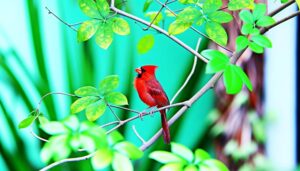There Are Cardinal Birds in Florida: A Birdwatcher’s Guide
Yes, Northern Cardinals (Cardinalis cardinalis) are prevalent in Florida, thriving in habitats ranging from coastal mangroves to suburban parks. These non-migratory birds exhibit strong territorial behavior and maintain year-round presence.
The males are easily identified by their striking red plumage and black facial mask, while females display more subdued tones. Cardinals prefer dense shrubbery and forest edges for nesting, and their diet primarily includes seeds, fruits, and insects.
Population density data indicates a robust presence, especially in urban areas. Explore further to uncover detailed insights into their behaviors, habitats, and adaptations to Florida's unique ecosystems.

Key Takeaways
- Northern Cardinals are the most common cardinal species in Florida.
- Cardinals thrive in Florida's diverse habitats, including coastal mangroves and urban parks.
- They are visible year-round due to their non-migratory nature.
- Cardinals prefer dense shrubbery and forest edges for nesting in Florida.
- Suburban areas in Florida have high cardinal population density.
Cardinal Birds Overview
Northern Cardinals (Cardinalis cardinalis) are a prominent avian species characterized by their vibrant red plumage in males and their distinctive melodic songs, making them a subject of extensive ornithological studies.
These passerine birds exhibit sexual dimorphism; males possess striking red feathers, while females display more subdued brownish tones with hints of red.
Cardinals are non-migratory and demonstrate territorial behavior, particularly during the breeding season. Their diet comprises primarily seeds, fruits, and insects, which they forage both on the ground and in low foliage.
Studies indicate their adaptability to diverse habitats, including woodlands, gardens, and suburban areas. Population data suggests stability across their range, attributed to their generalist feeding habits and ability to thrive in human-altered landscapes.
Cardinal Species in Florida
In Florida, the cardinal species most frequently observed is the Northern Cardinal (Cardinalis cardinalis), which flourishes in the state's diverse ecosystems, from coastal mangroves to urban parks.
This species displays a high adaptability to various habitats, shown in its widespread distribution across Florida's peninsular and panhandle regions. Data from the Florida Breeding Bird Atlas indicate a strong population density, especially in suburban areas where feeders offer supplementary nutrition.
Research emphasizes that the Northern Cardinal's presence is positively linked to the availability of dense shrubbery and forest edges, which provide crucial nesting sites and foraging opportunities.
Furthermore, the species' non-migratory behavior guarantees year-round visibility, rendering it a consistent focus of ornithological studies and birdwatching activities.
Northern Cardinal Identification
Characterized by its vibrant red plumage and distinct crest, the Northern Cardinal (Cardinalis cardinalis) exhibits sexual dimorphism, with males displaying more vivid coloration compared to the more subdued tones of the females.
The male Northern Cardinal's feathers range from a deep red to a scarlet hue, while the female typically presents a brownish color with tinges of red on the wings, tail, and crest. Both genders exhibit a prominent black mask surrounding their beak, which is thick and orange-red.
Juveniles resemble females but are more brownish overall. This species measures approximately 21-23 centimeters in length, with a wingspan of about 25-31 centimeters. Their robust, conical beak is adapted for seed consumption, a critical aspect of their diet.
Florida's Cardinal Habitats
Florida's cardinal habitats are mainly situated in dense shrublands, forest edges, and suburban gardens. These locations provide ample shelter and food resources for the birds. Ideal habitat features include thick understory vegetation, abundant berry-producing plants, and a consistent water source.
Data from recent ornithological surveys highlight the prevalence of Northern Cardinals in regions with high native plant diversity. This diversity supports their nesting and foraging needs.
Common Cardinal Locations
How do cardinal populations thrive across diverse habitats in Florida, ranging from dense forests to suburban gardens?
Cardinals (Cardinalis cardinalis) exhibit remarkable adaptability, inhabiting various ecosystems throughout the state.
In dense forests, cardinal populations benefit from the abundant foliage that provides shelter and nesting sites.
Suburban gardens offer an equally favorable environment due to the availability of bird feeders and ornamental shrubs, which simulate their natural habitat.
Data from the Florida Fish and Wildlife Conservation Commission indicate that cardinals are particularly prevalent in regions with mixed hardwood and pine forests.
Additionally, urban green spaces and parks have seen a steady increase in cardinal sightings, suggesting their resilience and ability to exploit anthropogenic landscapes for survival and reproduction.
Ideal Habitat Features
Understanding the cardinal's habitat preferences in Florida reveals that these birds favor environments offering dense understory vegetation, plentiful food sources, and safe nesting areas.
Primarily, Northern Cardinals (Cardinalis cardinalis) thrive in habitats such as mixed woodlands, shrublands, and suburban gardens. Dense thickets and hedgerows provide essential cover, shielding them from predators and harsh weather. These habitats also support a diverse array of fruit-bearing plants and seed-producing flora, ensuring a steady diet.
Data indicates that cardinals frequently inhabit areas with low to moderate human disturbance, which aligns with their preference for secluded nesting sites. Availability of water sources—such as ponds or birdbaths—enhances habitat suitability, promoting higher cardinal densities.
Habitat complexity plays a crucial role in cardinal distribution in Florida.
Seasonal Changes
Seasonal changes have a strong influence on the behavior and physiology of cardinal birds in Florida. Migration patterns are particularly minimal in this region, as cardinals are mostly non-migratory, but alterations in photoperiods and temperature trigger distinct breeding activities mainly between March and September.
Additionally, winter adaptation behaviors include changes in foraging strategies and increased reliance on available food resources to maintain energy homeostasis.
Migration Patterns Overview
During the annual cycle, cardinal birds in Florida exhibit distinct migration patterns influenced by seasonal variations in temperature and food availability.
Unlike many avian species, Northern Cardinals (Cardinalis cardinalis) are generally non-migratory, remaining within their established territories year-round. However, fluctuations in local populations can occur due to minor altitudinal movements driven by climatic conditions.
Data from ornithological studies indicate that cardinals may shift their range slightly within Florida to optimize access to food resources, particularly during colder months when insect populations decline. These movements are usually limited to a few kilometers.
Seasonal food scarcity may also prompt cardinals to exploit suburban areas where bird feeders are prevalent, thereby minimizing energy expenditure associated with foraging in natural habitats.
Breeding Season Information
As seasonal changes influence the availability of resources, Northern Cardinals in Florida enter their breeding season, typically commencing in late winter and extending through early summer. This period is characterized by heightened vocalization and territorial behavior, as males establish and defend breeding territories. Female cardinals select nesting sites with dense foliage to provide cover and protection. The table below illustrates key breeding season parameters:
| Parameter | Description | Timing |
|---|---|---|
| Breeding Season Start | Late winter | February |
| Breeding Season End | Early summer | June |
| Peak Nesting Period | Heightened nesting activity | March – April |
| Incubation Period | Time taken for eggs to hatch | 11-13 days |
| Fledging Period | Time taken for chicks to leave the nest | 9-11 days |
These data-driven observations highlight the intricate timing and behaviors associated with the cardinal's reproductive cycle.
Winter Adaptation Behaviors
Northern Cardinals in Florida exhibit a range of winter adaptation behaviors. This includes altered foraging patterns and increased reliance on evergreen vegetation for shelter. These behavioral adjustments are essential for survival during colder months when resources become scarce.
Observations indicate that cardinals increase their consumption of high-energy food sources, such as seeds and berries, to maintain their metabolic rates. Additionally, they utilize dense, evergreen foliage to protect themselves from harsh winds and lower temperatures.
Increased seed consumption is vital for sustaining energy levels during winter.
Sheltering in evergreens provides necessary insulation against cold weather.
Altered social behavior, such as flocking together, reduces predation risk and increases foraging efficiency.
These adaptations demonstrate the Northern Cardinal's resilience and ability to thrive in varying seasonal conditions.
Diet and Feeding
The diet of cardinal birds in Florida mainly consists of seeds, fruits, and insects, with a particular preference for sunflower seeds and berries, as evidenced by observational studies and dietary analyses.
These birds exhibit a granivorous inclination, favoring seeds from grasses and various plants. Insect consumption, including beetles and caterpillars, provides essential proteins and lipids, vital during breeding seasons.
Data indicate a seasonal variation in their diet, with an increased intake of fruits such as dogwood and grape during autumn.
The availability of food sources greatly influences their foraging behavior and habitat selection. Supplemental feeding by humans, particularly through bird feeders, has been shown to alter their natural diet, underscoring the importance of understanding ecological impacts.
Mating and Nesting
Mating and nesting behaviors of Cardinal birds in Florida exhibit intricate courtship rituals. This includes the male's vibrant display of plumage and song.
The selection of nesting sites is strategic, often favoring dense shrubbery or low trees to minimize predation risks.
Once the eggs are laid, the incubation period typically spans 11 to 13 days. During this time, both parents may participate in guarding and nurturing the nest.
Courtship Behavior Rituals
In the unique ecosystem of Florida, the courtship behavior of cardinal birds is characterized by intricate rituals that include vocal duets, food exchanges, and synchronized movements, serving both to attract mates and to strengthen pair bonds. These behaviors are critical for reproductive success and have been meticulously documented through field observations and bioacoustic analysis.
Vocal duets: Males and females engage in complex, coordinated song sequences that signify their compatibility.
Food exchanges: Males present food to females as a form of nuptial gift, demonstrating their capability to provide.
Synchronized movements: Pairs perform coordinated flights and perching patterns, enhancing their mutual attraction and synchronization.
These rituals underscore the importance of behavioral ecology in the mating strategies of cardinal birds in Florida.
Nesting Site Selection
Frequently, cardinal birds in Florida exhibit meticulous selection of nesting sites, prioritizing locations that offer ideal protection from predators and environmental elements. Typically, these sites are situated in dense shrubbery or thickets, which provide concealment and structural support.
According to ornithological studies, cardinal nests are often found at heights ranging from 1 to 15 feet above ground, optimizing both accessibility and safety. The materials used for nest construction include twigs, leaves, and grasses, with finer materials lining the interior for added insulation.
Research indicates that cardinals prefer native plants such as saw palmetto and myrtle oak, which enhance nest concealment. This strategic site selection is important for ensuring reproductive success and chick survival in the diverse Florida ecosystem.
Egg Incubation Period
The egg incubation period for cardinal birds in Florida typically spans 11 to 13 days. During this time, the female remains mainly responsible for maintaining the best temperature and humidity levels within the nest. The precise regulation of these environmental factors is essential for embryonic development and successful hatching.
Female cardinals engage in periodic turning of the eggs, which secures uniform heat distribution and prevents embryonic adhesion to the eggshell.
Witness the delicate balance of life: The meticulous care taken by the female cardinal highlights the intricate processes of avian reproduction.
Marvel at nature's precision: The exactness required in maintaining temperature and humidity underscores the complexity of natural systems.
Feel the anticipation: The short incubation period fosters a sense of urgency and anticipation, reflecting the fragility and wonder of new life.
Birdwatching Tips
Observing Cardinal birds in Florida can be enhanced by understanding their preferred habitats, peak activity periods, and dietary preferences. Cardinals favor dense shrubbery and woodland edges, often found in suburban gardens with ample cover.
Peak activity typically occurs during early morning and late afternoon, aligning with crepuscular behaviors. Cardinals primarily consume seeds, grains, and fruit; incorporating sunflower seeds into feeders can notably increase sighting opportunities.
Using binoculars with at least 8x magnification ensures clear observation, while field guides assist in accurate identification. Tracking seasonal variations in behavior and population density through citizen science programs like eBird can provide valuable data.
Monitoring these factors enhances the likelihood of successful and enriching birdwatching experiences in Florida's diverse ecosystems.
Popular Spotting Locations
Where can one most effectively observe Cardinal birds in Florida?
Prime locations are characterized by dense vegetation and abundant food sources. The Northern Cardinal (Cardinalis cardinalis) thrives in habitats such as woodlands, gardens, and shrublands.
- Everglades National Park: This vast, biodiverse area provides an ideal environment with its subtropical climate and extensive foliage.
- Ocala National Forest: Renowned for its sand pine scrub and longleaf pine forests, this area is a haven for cardinal sightings.
- Corkscrew Swamp Sanctuary: Managed by the Audubon Society, this sanctuary boasts a rich ecosystem of bald cypress trees and diverse avian species, including the Northern Cardinal.
These locations offer excellent opportunities for birdwatchers to observe and document the behavior and characteristics of this vibrant species.
Conservation Status
Understanding the conservation status of the Northern Cardinal in Florida is essential for ensuring its continued presence in these diverse habitats.
The Northern Cardinal (Cardinalis cardinalis) is currently classified as a species of least concern by the International Union for Conservation of Nature (IUCN). This designation is based on its broad distribution and stable population trends.
In Florida, habitat preservation efforts in areas such as state parks and wildlife reserves provide vital support for their nesting and feeding requirements. However, ongoing monitoring is crucial to detect any potential threats from habitat loss or environmental changes.
Data from the North American Breeding Bird Survey indicates that the population in Florida remains robust, reflecting successful conservation practices and the adaptability of this species.
Cardinals and Climate
Adapting to the subtropical climate of Florida, Northern Cardinals exhibit behavioral and physiological adjustments that enable them to thrive despite seasonal variations and extreme weather events. These birds exhibit increased metabolic rates during cooler months, aiding in thermoregulation. Their robust cardiovascular systems are well-suited to handle the high humidity and elevated temperatures characteristic of Florida's summer.
Additionally, cardinals display a unique molting pattern, shedding feathers gradually to avoid exposure to harsh weather.
- Resilience: Cardinals endure hurricanes and tropical storms, demonstrating their remarkable survival instincts.
- Adaptation: Their diverse diet, including seeds, fruits, and insects, guarantees sustenance year-round.
- Beauty: The striking plumage of cardinals stands out against Florida's verdant landscapes, providing a visual delight.
Fun Facts About Cardinals
In addition to their impressive adaptability to Florida's climate, Northern Cardinals boast several intriguing characteristics that highlight their unique biology and behavior. Scientifically known as *Cardinalis cardinalis*, these birds exhibit sexual dimorphism; males are vibrant red, while females possess a more subdued tan coloration with red accents.
Cardinals are monogamous, often forming lifelong pair bonds. Their diet includes seeds, fruits, and insects, which they forage using their robust, conical beaks. Significantly, they are non-migratory, maintaining territories year-round.
Cardinals communicate through a repertoire of melodious whistles and songs, with both sexes capable of vocalization, a rarity among songbirds. Additionally, these birds exhibit a unique behavior called 'anting,' where they apply ants to their feathers, possibly for pest control.
Conclusion
In Florida, Northern Cardinals epitomize avian splendor, thriving across diverse habitats from dense woodlands to suburban gardens. Seasonal variations influence their behavior and visibility, while conservation efforts guarantee their enduring presence.
The resilience of these striking red birds serves as a barometer for environmental health, highlighting the intricate balance within Florida's ecosystems. Observing cardinals offers a window into the dynamic interplay of climate, habitat, and biodiversity, underscoring the importance of sustained ecological stewardship.






